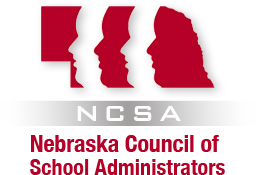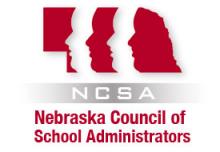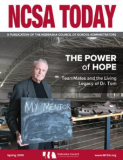Blended Learning Basics
BY DAWN FERREYRA, eLearning and Distance Education Supervisor, Omaha Public Schools and Educational Service Unit #19
Blended Learning, the blending of online and in-class instruction, is a much-discussed instructional model with great promise. When implemented well, blended learning has shown to have a greater impact on student achievement than traditional classroom instruction (Means et al., 2010; Schulte, 2011). Blended learning teachers also report that students are more engaged in their learning with fewer absences. But what exactly is blended learning?
The Clayton Christensen Institute defines blended learning as a “a formal education program in which a student learns: (1) at least in part through online learning with some element of control over time, place, path, and/or pace; (2) at least in part in a supervised brickand-mortar location away from home; (3) and the modalities along each student’s learning path within a course or subject are connected to provide an integrated learning experience” (Christensen, 2014). In simpler terms, blended learning is a mix of internet-based and face-toface teaching that allows the learner to have a personalized, teacher-directed learning experience through enhanced choice, customization, and communication.
Choice
Choice, whether it is time, place, or path, is the key to blended learning. Time and place limitations are no longer a factor in the blended learning classroom. Because instruction is delivered online as well as within the traditional classroom walls, students, using internet access, have access to instruction at any time of the day or night—anywhere they want. Learning can happen beyond the bell, with students reviewing modeled lessons, researching and investigating, discussing, and submitting work. Be it snow day or sick day, learning can continue with little interruption.
Often in a blended learning environment, students are given choice in activity or lesson selection. Learning does not need to be linear; rather students are presented with several options and may choose the path they take throughout the lesson or unit. While planning for this type of differentiation is time intensive, teachers find that the right technology tools allows them to save time in the long run.
Customization
Students working in a blended learning environment may also have flexibility in their learning path. Teachers can quickly and easily customize learning by differentiating for learning level, style, and/or interest. Carol Tomlinson states that differentiation is the teacher’s response to the learner’s needs (2008). The use of online tools allows teachers to instantly assess and track student progress through online checks for understanding and leveled learning activities, and then customize learning progressions that can assist in remediation or acceleration.
Customization still happens in the traditional classroom environment, yet it can be enhanced through online differentiation strategies. Teachers can direct the learning path, or the teacher can rely on computerized programs that assess student learning and recommend learning progressions. The goal is for all students to receive a personalized instructional plan that focuses on increasing student achievement and mastery of standards.
Communication
The blended learning classroom is dependent upon teacher-student communication, including timely instructional feedback—the instructional strategy that shows the greatest impact on student achievement. Teachers must regularly interact with students both in the face-to-face environment and online in order to increase student success and engagement.
Blended Learning is often seen as just adding technology to the classroom. More technology does not equate increased achievement, and, while technology should be present in every 21st Century classroom, all too often it becomes a tool for productivity rather than driving innovative teaching and learning strategies. True blended learning focuses on student needs and leverages the available technology to create a relevant engaging classroom. Blended learning bridges the gap between pedagogy and technology.
What It Isn’t
Technology Rich Classrooms (TRCs) are sometimes mistaken for blended learning classrooms. In a technology rich classroom, the teacher has several technology tools to choose from when delivering instruction. It might be the use of an interactive whiteboard or document camera for lesson delivery, a list of websites for students to use during centers, or a digital dropbox for student work.
There are so many tools being used in a TRC, so why isn’t it considered blended learning? A blended learning classroom must have the three C’s: choice, customization, and communication— which are not present in a technology rich classroom. Though technology is being used in many different ways, the teacher is maintaining sole control over its use. It is the teacher who delivers the lessons using the interactive whiteboard (hopefully with some engagement with students), the teacher who determines which websites to use, and the teacher who controls the dropbox for student work. Students have little say in the digital environment or the selection of tools. Little space is created for choice, and, because the teacher is in control of the technology, there is also little room for customization. All students get the same, and while the materials may be differentiated for student reading or skill level, materials aren’t customized for learning style, modality, pace, or learning path.
Technology rich classrooms make up the majority of the classrooms in the United States. Technology is used in these classrooms at very specific times- teachers use tech tools throughout direct instruction, and students are directed to technology activities during independent work times. When technology is incorporated into projects, the tools are taught directly with specific outcomes- such as create a PowerPoint about your topic. Teachers in TRCs are often experts in their content area who have substituted traditional classroom tools for technology-based tools. While some teachers are comfortable staying in a TRC and are unwilling to change their teaching environment, many teachers are ready to move beyond the tools and look at new ways to engage students in learning- that is where blended learning comes in.
Moving Beyond Technology Rich
To successfully implement blended learning, you must first decide on technology systems that will support your online environment. Many schools select a learning management system as the online classroom space in which students and teachers interact. A learning management system or LMS is a software application designed to deliver online courses. A strong LMS allows a school district to create, distribute, and implement standardsbased, asynchronous instruction to provide guaranteed learning experiences for students in non-traditional or blended learning environments.
In addition to a learning management system, schools may choose to use Google or Microsoft classroom tools, teacher-created websites, or social tools such as Edmodo or Collaborize Classroom. Online tools such as Blendspace or EDpuzzle can also assist in building a blended learning space. It is important to select the right tool for your building’s needs as the technology selected will determine how teaching and learning will impact students. The chosen online system should be flexible to work with any device, any learning object (documents, videos, presentations, etc), and easy enough for both teachers and students to use that it will become an essential part of the classroom.
Students do not need one-to-one technologies, but they do need access to online resources for some portion of their learning. Choosing a learning model for blended learning implementation is vital. Four models are typically used when describing blended learning: Rotation, Flex, A La Carte, and Enriched Virtual. The rotation model is most used when teachers begin blending. Classrooms with a few computers or laptops can easily implement a rotation model in which students move from station to station (teacher station, computer station, independent or small group work station). Teachers may also decide to flip their learning so students are accessing teaching videos at home, or work in a lab rotation in which some of the learning happens in a traditional classroom, and then students move to a computer lab for their online learning station. Whatever the model, it is essential that clear procedures are in place and students are familiar with all classroom routines that support the blended learning model.
Teachers must be ready to teach in a blended learning environment, as it takes time to prepare or find digital content and create engaging learning paths. Teachers are managing both a physical and digital classroom, so professional development is essential. Understanding how to structure learning opportunities, how to assess and monitor student progress, and how to talk with families about a blended classroom are all important topics to cover before beginning. Administrators must also consider teacher evaluation, the costs of technology and professional support, and how effectiveness will be evaluated. Blended learning may not be right for all teachers, so having a strong implementation plan is essential for success.
The path to blended learning can be especially rewarding for both students and teachers. Nebraska’s Educational Service Units support the Nebraska BlendEd initiative, and can assist with blended learning planning and implementation. iNACOL, the International Association for K-12 Online Learning, and the Clayton Christensen Institute are both expert sources for research and blended learning models, and you can find a wealth of resources at http://www.blendedlearning.org/resources/ that will help you start your blended learning journey.






















